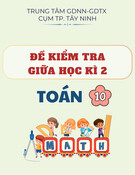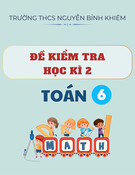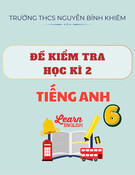
1)Có 2 cặp phương trình hóa học dưới đây, hãy xác định phương trình nào được viết
đúng theo tỉ lệ số mol của chất oxi hóa và chất khử tham gia phản ứng? Giải thích
2MnO
4
+ 3H2O2 + 6H 2Mn
2
+ 4O2 + 6H2O (a)
2MnO
4
+ 5H2O2 + 6H 2Mn
2
+ 5O2 + 8H2O (a')
FeSO4 + 4HNO3 Fe(NO3)3 + H2SO4 + NO2 + H2O (b)
FeSO4 + 6HNO3 Fe(NO3)3 + Fe2(SO4)3 + 3NO2 + 3H2O (b)
2/ Đun nóng dung dịch sắt (II) axetat với axit pecloric đặc thu được dung dịch sắt (III)
peclorat, khí clo và khí X. Lập phương trình hóa học (dạng phân tử) của phản ứng oxi
hóa – khử trên.
3/ Lưu huỳnh có thể tạo ra nhiều axit chứa oxi có công thức chung là HxSyOz. Một trong
số muối natri của những axit trên là NaxSyOz phản ứng với dung dịch KMnO4 có mặt
HNO3 theo sơ đồ sau:
NaxSyOz + KMnO4 + HNO3 MnSO4 + Na2SO4 + KNO3 + H2O
Biết rằng 0,01 mol NaxSyOz phản ứng vừa đủ với 200 ml dung dịch KMnO4 0,2M tạo
thành dung dịch chứa 4,8 gam ion SO
2
4
, nếu tách riêng Na2SO4 tạo ra thì khối lượng
riêng của nó là 1,42 gam.
a) Xác định số oxi hóa củ lưu huỳnh trong muốn NaxSyOz trên.
b) Hoàn thiện phương trình hóa học trên.
4/ Có 200 ml dung dịch A chứa hỗn hợp bari nitrat và sắt (III) nitrat. Cho từ từ dung dịch
nitrat cacbonat vào dung dịch Aminoaxit cho đến khi kết tủa không tạo thêm nữa. Kết tủa
thu được có khối lượng là 3,04 gam, đem tác dụng với dung dịch HCl dư thấy thoát ra
0,244 lít khí (1 atm, 25oC). Viết các phương trình hóa học và xác định nồng độ mol các
chất trong dung dịch A.
Câu II.
1/ Dẫn 1 lít hỗn hợp khí gồm NH3 và O2 vào bình phản ứng rồi thực hiện phản ứng cháy.
Kết thúc phản ứng, dẫn hỗn hợp tạo thành đi qua nước thấy chỉ còn 0,2 lít khí không tan
trong nước. Các thể tích khí đo cùng điều kiện về nhiệt độ và áp suất. Biết rằng không
xảy ra tương tác giữa sản phẩm cháy với các khí ban đầu để tạo ra chất mới. Tìm thành
phần phần trăm thể tích NH3 trong hỗn hợp đầu.
2/ Khi trộn dung dịch hai muối có cùng số mol tạo thành 1,25 gam chất X (kết tủa) và
dung dịch Y, X là muối của kim loại M (M có hóa trị 2 trong hợp chất). Tách riêng X rồi
đem nung đến 1100oC, muối X bị phân hủy thành 0,7 gam oxit MO và oxit Z (khí). Cô
cạn dung dịch Y thu được 2 gam chất rắn là một muối khan, muối này bị phân hủy ở
215oC tạo ra 0,024 mol oxit T (khí) và 0,9 gam hơi nước. Xác định công thức phân tử hai
muối ban đầu và viết các phương trình hóa học, biết số mol MO thu được bằng số mol Z.
Câu III/
1/ Công thức chung của Ankan là CnH2n+2.
a) Tìm số electron có mặt và số electron tham gia tạo thành liên kết trong phân tử ankan.
b) Trong phân tử ankan Aminoaxit chứa x nguyên tử cacbon bậc 1, y nguyên tử cacbon
bậc 2, z nguyên tử cacbon bậc 3 và t nguyên tử cacbon bậc 4. Tìm biểu thức tính z theo
các giá trị đã cho.
c) Trong phân tử ankan X số liên kết giữa nguyên tử cacbon và hiđro gấp 2,8 lần số liên
kết giữa hai nguyên tử cacbon. Khi clo hóa X chỉ tạo ra 3 dẫn xuất monoclo, còn nếu clo
hóa trong điều kiện khó khăn hơn sẽ tạo ra 7 dẫn xuất điclo. Tìm công thức cấu tạo X.
2/ Cho khí clo đi qua CHCl3 (nhiệt độ sôi là 62oC) kèm theo chiếu sáng tạo ra hai hợp
chất của cacbon là X1, X2 và chất khí Y. Y hòa tan tốt trong nước. Thành phần X1 và X2
trong hỗn hợp tạo thành phụ thuộc vào cường độ chiếu sáng, khi cường độ chiếu sáng yếu
tạo ra chủ yếu là X1 (nhiệt độ sôi là 77oC); khi cường độ chiếu sáng mạnh tạo ra chủ yếu

là chất rắn X2 có khối lượng mol lớn hơn X1 (bốc cháy ở 187oC). Giải thích (bằng cơ chế
phản ứng ) và cho biết công thức phân tử các chất Y, X1, X2.
Câu IV.
1/ Hòa tan 2,07 gam axit cacboxylic đơn chức HA và 50 gam nước thu được dung dịch
có khối lượng riêng là 1,03g/ml trong đó tổng số mol in H+ và A- là 1,267.10-3. Biết độ
điện li của axit HA bằng 1,42%.
a) Tìm công thức phân tử của axit trên
b) Tính hằng số phân li cua axit trên.
2/ Để tổng hợp CH3OH có thể thực hiện phản ứng CO + 2H2 CH3OH. Người ta
trộn 4 mol khí CO với 1 mol khí H2 rồi cho vào bình phản ứng tổng hợp CH3OH ở nhiệt
độ 450oC. Hiệu suất phản ứng này là 20%.
a) Hỏi áp suất trong bình phản ứng thay đổi bao nhiêu lần?
b) Tính hằng số cân bằng Kc của phản ứng ở nhiệt độ 450oC
c) Tìm số mol CO cần đem trộn với 1 mol H2 ở cùng nhiệt độ trên để hiệu suất phản ứng
là 25%.
Câu V
1/ Viết phương trình hóa học (dưới dạng công thức cấu tạo) biểu diễn các biến hóa sau
(ghi rõ điều kiện phản ứng, nếu có):
C6H5CH3 p O2NC6H4Cl p O2NC6H4CH2OH p O2NC6H4CHO p
O2NC6H4COOH p H2NC6H4COOH p HOC6H4COOH
p Cl N
2
C6H4COOH
2/ Từ etilen và các chất vô cơ cần thiết khác, hãy viết các phương trình hóa học để tạo ra
5 ancol khác nhau, mà phân tử có không quá 4 nguyên tử cacbon.
Câu VI
1/ Có sơ đồ chuyển hóa sau:
Biết A có công thức C6H12O3; Y có công thức C3H6O3 và có trong sữa chua; từ 4,45 gam
Z đem phản ứng với HNO2 thu được 4,5 gam Y (coi hiệu suất phản ứng là 100%). Xác
định công thức cấu tạo các chất A,B,D,E,G,Y,Z,T.
2/ Khi thủy phân hoàn toàn 1mol pentapetit X thì thu được 3 mol glyxin, 1mol alamin,
1mol valin. Khi thủy phân không hoàn toàn X thu được hỗn hợp sản phẩm gồm 3 tripetit
và 3 đipeptit. Khi xác định đầu N của animo axit trong tripetit trên thấy rằng 2 trong só
đó có đầu N của amino axit thuộc về glyxin, còn lại thuộc về alamin. Cho X tác dụng với
HNO2 thấy giải phóng N2. Xác định trình tự các amino axit trong phân tử X.
Cho H=1; C=12; N=14; O=16; Na=23; Mg=4; S=32; Ca=40; Fe=56; Ba=137
(Hết)
Nhờ các thầy giải giúp nghe
X
B
D
E
G
[O]
[O]
+Br2/P xúc tác
+HCl
+HNO2
+C2H5OH/HCl
Z
Y
+NaOH
A

- 1 -
ĐỀ THI HỌC SINH GIỎI 12
MÔN : TIẾNG ANH - LẦN II
PART I : VOCABULARY ( 20pts )
A . Choose the word/ phrase which best completes each sentence :
1. Please sit down and ........................... yourself at home .
A. do B. made C. help D. get
2. When her father was younger , he ....................... a fortune selling clothes .
A. did B. made C. does D. makes
3. Did they ask you what examinations you’ve ...................... ?
A. overcome B. passed C. succeeded D. obtained
4. Have you been for an ...................... yet ?
A. overview B. inspection C. appointment D. interview
5. Jane ...................... to write back as soon as she got my letter but months can go by before I get a
reply these days .
A. has always used B. always use C. always used D. is always used
6. It was not until she arrived in class ...................... realized she had forgotten her book.
A. and she B. when she C. she D. that she
7. We have been informed that ...................... animals at the 200 are starving to death.
A. most of B. almost the C. most all D. most of the
8. The firm went bankrupt and their shares became ......................
A. priceless B. unworthy C. invaluable D. worthless
9. Two of the boys in the art class were doing self- portraits by looking at ...................... in the
mirror .
A. each other B. oneself C. themselves D. one another
10. The shop assistant ...................... me so much for the book .
A. cost B . requested C. required D. charge
B. Complete each sentence by giving the correct form of word in bracket :
1. The book describes the ...................... between a mother and her son . (RELATE)
2. There is a lovely description of the author’s early ...................... (CHILD)
3. The teacher warned the children that if they ...................... again, they’d be punished.
( BEHAVE)
4. Great works of art like the Mona Liza are ...................... ( PRICE )
5. What a lovely painting ! Your daughter much be very ...................... (ART )
6. Librarians spend a lot of their time ...................... books . ( CLASS )
7. Some people claim to be able to ...................... the future . ( TELL )
8. “ A Taste of Death ” is about two famous men who are found ...................... in a church .
( DIE )
9. In the past few years this area has become heavily ...................... . ( INDUSTRY )
10. Please don’t be so ...................... , I can’t do all the work by my self . ( REASON )
PART II : READING PRACTICE ( 30 pts)
A. Cloze Test : Fill in each of the numbered blanks in the passage with one suitable
word :
ENDANGERED SPECIES
The future of the African elephant depends on man . No (1)................. can human
beings and (2) ................. animals live in harmony throughout vast areas of (3) .................
continent as was possible in days gone by, for man’s needs have increased as well

- 2 -
(4)................. his numbers. There are regions , (5) ................. as the Congo forests and the
equatorial Sudan , (6) ................. the old relationship may remain for a (7) .................
more years or even generations but in general it has gone . Conservation , (8)
................. it is to be effective , must be a positive , constructive policy, (9) ................. it
is wishful thinking to imagine otherwise, (10) .................in the case of the elephant.
And if this is not yet true of the whole of (11) ................. , it soon will be for the
increase (12) ................. the human population is almost universal .Where human (13)
................. and wild animals find themselves in competition (14) ................. each other,
the animals will lose . Even if there appears to be (15) ................. room for both, man
will not tolerate for long a situation in (16) ................. elephants and other creatures
make even occasional raids (17) ............... his fields of food or economic crops. For
many years this has been (18) ................. major cause of conflicting interests and (19)
................. of the reasons why so many elephants have been (20) ................. to control
their numbers.
1. .............................................. 2. ..............................................
3. .............................................. 4. ..............................................
5. .............................................. 6. ..............................................
7. .............................................. 8. ..............................................
9. .............................................. 10. ..............................................
11. .............................................. 12. ..............................................
13. .............................................. 14. ..............................................
15. .............................................. 16. ..............................................
17. .............................................. 18. ..............................................
19. .............................................. 20. ..............................................
B. READING COMPREHENSION :
Read the following text and choose the best answer for each question :
Over the past 600 years, English has grown from a language of few speakers to
become the dominant language of international communication. English as we know it to
day emerged around 1350, after having incorporated many elements of French that were
introduced following the Normal invasion of 1066. Until the 1600s, English was, for the most
part, spoken only in England and had not extended even as far as Wales, Scotland, or
Ireland.
During the course of the next two centuries, English began to spread around the
globe as a result of exploration, trade ( including slave trade ), colonization , and missionary
work. Thus , small enclaves of English speakers became established and grew in various
parts of the world. As these communities proliferated, English gradually became the
primary language of international business, banking, and diplomacy.
Currently, about 80 percent of the information stored on computer systems world
wide is in English. Two thirds of the world’s science writing is in English, and English is the
main language of technology, advertising, media, international airports, and air traffic
controllers .
Today there are more than 700 million English users in the world, and over half of
these are nonnative speakers, constituting the largest number of nonnative users than any
other language in the world.
1. What is the main topic of this passage ?
A. the number of nonnative users of English
B. the French influence on the English language

- 3 -
C. the expansion of English as an international language
D. the use of English for science and technology
2. As used in line 3 , the word “ elements ” is not similar to which of the following :
A. declaration B. features C. curiousities D. customs
3. English was spoken in .......................... in the 1600s .
A. England B. Wales C. Scotland or Ireland D. all are correct
4. According to the passage all of the following contributed to the spread of English around the
world except
A. the slave trade B. the Norman invasion
C. missionaries D. colonization
5. Approximately when did English begin to be used beyond England ?
A. in 1066 B. around 1350 C. before 1600 D. after 1600
6. The word “ enclaves ” in line 9 could best be replaced by which of the following ?
A. communities B. organizations C. regions D. countries
7. The word “ proliferated ” in line 10 is closet in meaning to which of the following ?
A. prospered B. organized C. disbanded D. expanded
8. Which of the following is closet in meaning to the word “ constituting ” in line 17 ?
A. looking over B. sitting down C. doing in D. making up
9. According to the passage, approximately how many nonnative users of English are there in
the world to day ?
A. a quarter million B. half a million C. 350 million D. 700 million
10. According to the passage what does the writer mean ?
A. English is very important to master
B. English is necessary for business, technology advertising , media , international airports
and air traffic controllers
C. English is used in many countries in the world .
D. A, B , C are correct
C. FILL IN EACH BLANK WITH THE BEST FIT : (A, B , C , D )
Mr John Brown lived his entire life in a small town in the North of England . He
never left the house (1) ...................... he had been born, never married, never went on
holiday and had no friends . He worked in a local factory for (2) ...................... forty years
but even the people who had worked with him for years (3) ...................... very little about
him . He wore the same clothes year in year out, and (4) ...................... he shopped regularly
at the local store, he bought only the most basic foodstuffs, never changing his purchases
from one week to the next .
So (5) ...................... he died last month neighbors and local people were astonished to
learn that Mr Brown was not just a rich man, he was in fact (6) ...................... millionaire .
He had no bank account, no money invested anywhere but in the various drawers,
cupboards and boxes in the house there were hundreds and thousands of bank (7)
...................... and coins .
It took police over two weeks to clear the house and the bank clerks took just as long
to (8) ...................... all the money.
“We had absolutely no idae that he had been hiding his money over the years ” one of
his neighbours (9) ...................... “ In fact We used to feel sorry for him, We thought he was
a poor old man unable to (10 ) ...................... anything better for himself !”
1. A. which B. where C. who D. what
2. A. until B. above C. over D. across
3. A. reminded B. held C. had D. knew
4. A. although B. but C. because D. however
5.A. while B. when C. during D. that


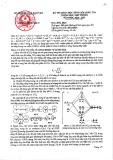
![Đề thi học sinh giỏi Quốc gia THPT môn Hoá học năm 2021-2022 có đáp án [Kèm đề thi]](https://cdn.tailieu.vn/images/document/thumbnail/2023/20230215/bapnuong09/135x160/2931676452944.jpg)





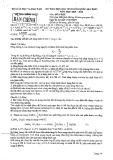
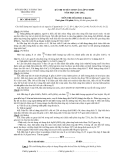

![Đề thi Tiếng Anh có đáp án [kèm lời giải chi tiết]](https://cdn.tailieu.vn/images/document/thumbnail/2025/20250810/duykpmg/135x160/64731754886819.jpg)




![Đề thi học kì 2 Vật lý lớp 11: Đề minh họa [Mới nhất]](https://cdn.tailieu.vn/images/document/thumbnail/2025/20250709/linhnhil/135x160/711752026408.jpg)
